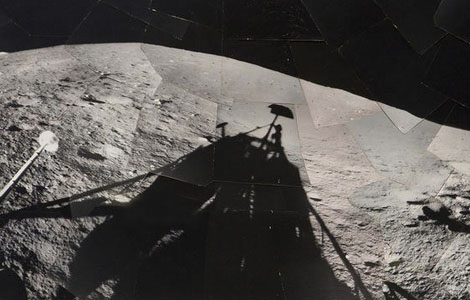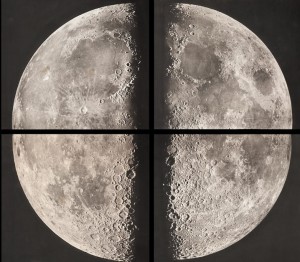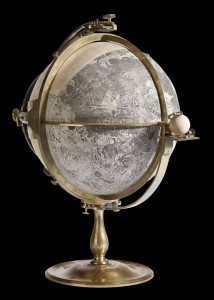Lunar History For Sale
A 16th-century telescope, Lunar Orbiter mission documents, early views of deep space, and more go on auction this week.

Detail from a unique wide-angle hand mosaic of Surveyor 1's shadow on the Oceanus Procellarum, June 13, 1966. The mosaic is made of 66 gelatin silver prints in all, and measures 18 by 59 inches. (Each image mounted on the mosaic is approximately 6 by 6 inches.) The piece (lot #62) is estimated to go for $80,000 to $100,000. Photograph courtesy Bonhams auction house.
If you grew up near Bethpage, New York in the early 1960s, you probably were obsessed with the Apollo Lunar Module built by the Long Island-based Grumman Corporation. And if you were an extremely prescient teenager, you might have started amassing your own world-class collection of space-related items, including photographs, manuscripts, and prints.

Pierre Henri Puiseux and Maurice Lowey's large-format quadrant of the moon. Photograph courtesy Bonhams.
This Wednesday, Bonhams is auctioning off one such private collection. In a video on Bonhams’ Website, the collector (who wishes to remain anonymous) explains that he grew up “during the height of the windup to the Apollo era,” just a few miles from Grumman, and many of the fathers in his neighborhood worked on the Lunar Module. “I was working towards a goal fairly early on,” he recalls in the video. “In my early- to mid-teens, what I wanted to do was to have an exhibition focusing on unmanned space travel.”
Many of the items are one-of-a kind. The lunar photomosaic above (see the full image here), was made as a five-foot-wide presentation piece in 1966, and was painstakingly assembled by Kay Larson of the U.S. Geological Survey using images captured by Surveyor 1. “I’m lucky to have found this—it would have been thrown in the trash, eventually,” the collector notes.
There are objects relating to Mars, Mercury, Venus, and Jupiter, but Earth’s moon is the centerpiece of this show. Some of the items predate the space age. One particularly lovely object is a photograph made up of four large-format quadrants of the moon, taken in 1899, and probably created for the 1900 Paris Exposition. The photogravures, by Pierre Henri Puiseux and Maurice Loewy, were taken at the Paris Observatory. “It was only with NASA’s Lunar Orbiters in the 1960s,” reads the collection note, “that images substantially better than those of Loewy and Puiseux were obtained.” The plates are from Puiseux and Loewy’s Atlas photographique de la lune. The two men were able to photograph the moon only during perfect weather, the catalog notes, which meant just 50 or 60 nights each year—explaining why the Atlas took 14 years to complete. These may be the first oversize plates from the Atlas to come up for auction, and are expected to bring $12,000 to $18,000.
British pastel portraitist John Russell (the appointed painter to the King and the Prince of Wales) was so fascinated with the moon that he created a lunar globe in 1797, which he called a Selenographia. Russell spent many years drawing and observing the moon; his globe even accounts for lunar motion, or libration. No more than 11 Selenographias are believed to exist; six are in public collections. This example, lot number 23, is expected to fetch between $200,000 to $300,000.
